Bears and lions are known for being some of the fiercest predators on the face of the planet. Interestingly, they do not share a range. Lions primarily live in sub-Saharan Africa, and bears live in North America, Europe, and parts of Asia. Still, we have to wonder what would happen if these two apex predators battled against another in a bear vs lion fight.
Being that we have no records of such a fight occurring in the wild, we will have to rely on the available data concerning these two carnivores to determine who would most likely win. Fortunately, we have all the information we need to make a highly educated hypothesis about which mammal emerges as the victor.
Comparing a Bear and a Lion
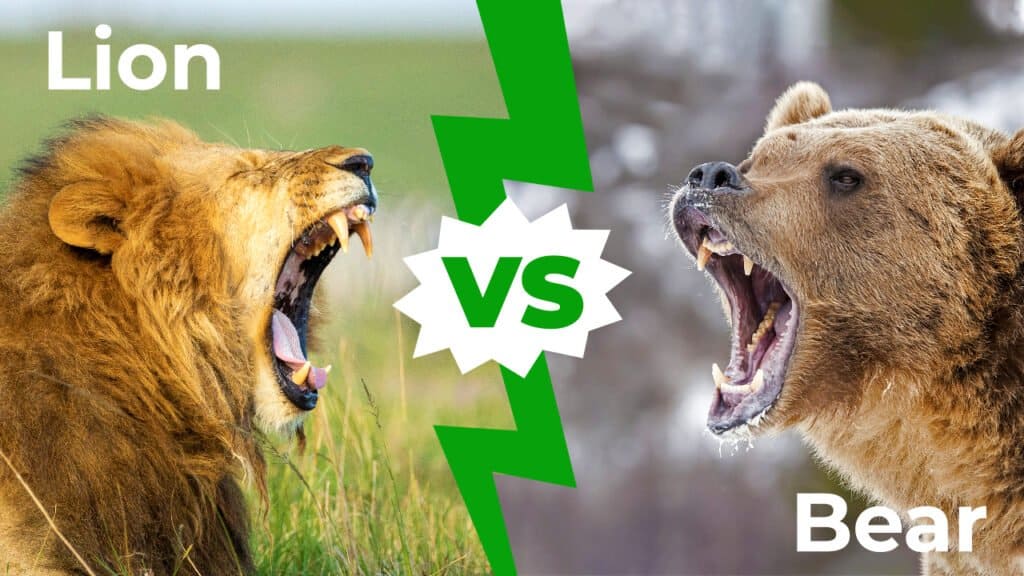
| Bear | Lion | |
| Size | Weight: 60lbs – 990lbs Height: 2ft – 5ft at shoulder, up to 9ft standing. Length: 4.5ft – 9.5ft | Weight: 264lbs – 550lbs Length: 4.7ft – 8.2ft |
| Speed and Movement Type | – 25-35 mph | -35 mph (up to 50mph for very short bursts) -Sprints to enemies |
| Bite Power and Teeth | – 1200 PSI bite power at maximum – 2-3-inch teeth – Teeth allow for bears to bite down, shake, and maul. | -650 PSI bite power -30 teeth including up to four, 4-inch canines |
| Senses | – Some bears can smell from several miles away – Hearing twice as good as humans – Good vision and some bears can see better at dusk. | -Amazing sense of sight, especially night vision. -Good sense of smell capable of smelling other lions’ markings -Great hearing allows them to hear prey miles away. |
| Defenses | – Large size – Speed to run away – Fierce threat displays – Ability to traverse land and water – Can climb trees to escape fights | – Stays with pride for safety in numbers – Large size – Can quickly run away from enemies |
| Offensive Capabilities | – Powerful, bone-breaking bites – Sharp claws that can tear open prey – Weight to pin down enemies – Ability to stand up and allow their weight to overwhelm quadrupeds, bringing them to the ground. | – Sharp claws can gash foes – Paw strikes can deliver a powerful, staggering blow – Strong biting power can splinter bones and tear prey open. |
| Predatory Behavior | – Ambush predator in some cases, waiting for prey – Opportunistic predator that pursues and kills prey – Typically secures a kill with a single, powerful bite to the throat. | – Primarily stalks and pounces on the opponent – Uses groups to take down prey |
The Key Factors in a Fight Between a Bear and a Lion
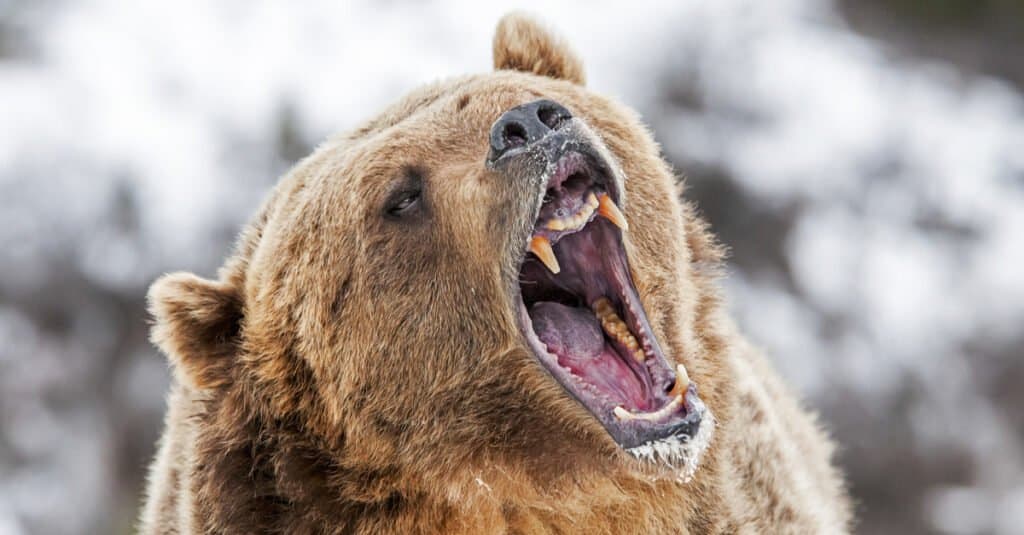
A bear vs lion fight would be determined by overall power and hunting ability.
©Scott E Read/Shutterstock.com
A bear vs lion battle would come down to a few broad factors like the physical components of each animal as well as their ability to fight others. We have prepared a list of seven different elements that would play a role in determining which of these animals would have the greatest chance of winning against the other.
Consider the physical portions of bears and lions along with the way they hunt and defeat prey.
Physical Features of Bears and Lions
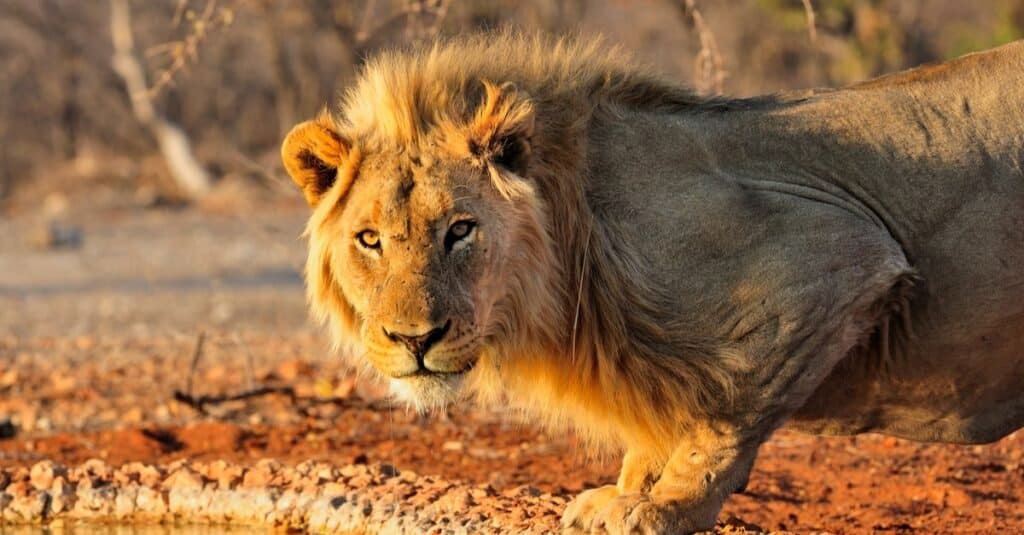
Lions and bears both run up to 35mph and are over 8ft long.
©Stephanie Periquet/Shutterstock.com
Bears and lions are both quadrupeds that have many differences in their physical characteristics. We have determined that elements like size, power, and senses would play a significant part in helping one conquer the other and become the predator of an apex predator.
Bear vs Lion: Size
Humans have weight classes for combat sports because size and weight play such a big role in helping one animal successfully attack another. In the wild, there are no weight classes. Bears can weigh up to 900lbs or more and can stand 9ft tall when they stand on two feet as they often do in fights. The largest bear on record was a polar bear that reached 2,209 pounds.
Lions can weigh up to 550lbs and have a length of 8ft at maximum. The largest lion ever tipped the scales at 827 pounds.
In this case, bears get the size advantage.
Bear vs Lion: Speed and Movement
Both lions and bears are speedy animals on land. A sprinting lion can reach speeds of 50mph for short times. A bear can reach the same speed, but it cannot sustain that maximum speed for as long as the lion.
Lions receive the advantage in terms of speed.
Bear vs Lion: Bite Power and Teeth
Bears and lions primarily rely on their bites to deal fatal blows to their prey. Bears have a powerful bite measuring 1,200PSI that pushes 3-inch teeth into enemies. Lions have a weaker bite force at 650PSI, but their canine teeth can reach 4 inches long!
Bears get the benefit of the biting power since it is almost double that of a lion.
Bear vs Lion: Senses
As predators, bears have amazing senses that help them find and kill prey. Their sense of smell is so developed that they can sniff out food from miles away. Their hearing is twice that of a human, and they have a sense of sight that gets better at dusk when many other animals are vulnerable.
Lions have an amazing sight at night and a good sense of smell. They can hear some of their prey from miles away.
Lions’ senses are slightly better overall, so they get the advantage for senses.
Bear vs Lion: Physical Defenses
Bears trust their massive size and frightening threat display to keep predators at bay, and it’s quite successful. They can also engage their speed to run from fights.
Lions can run from predators with tremendous speed, stay with their pride, and rely on its threat display to keep enemies away.
All in all, physical defenses are a tie for these two animals.
Combat Skills of Bears and Lions
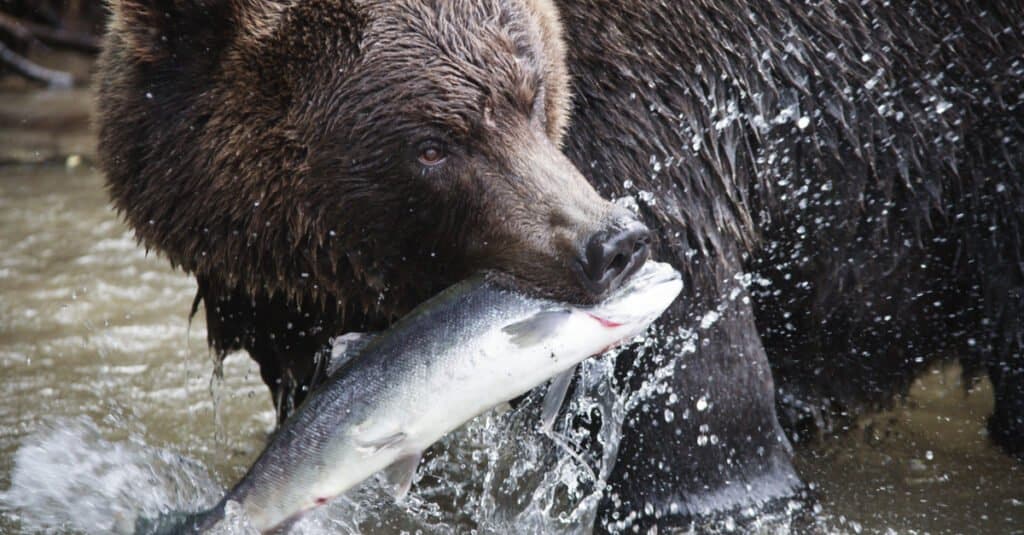
Bears are effective ambush predators just like lions.
©DPS/Shutterstock.com
Having a strong body is just one facet of a successful fighter. Experience, offensive prowess, and hunting abilities also matter in this battle of predators. Consider the combat skills of the lion and bear.
Bear vs Lion: Offensive Capabilities
The bear and lion both use their teeth to deliver a killing blow. Lions can use their front legs’ claws to wrap and dig into enemies and pin them beneath their weight, simultaneously biting and scratching prey.
Bears can use powerful paw strikes, scratching from sharp claws, and tremendously powerful biting to kill enemies. Both are similar in their offensive competencies, but the bear is a lot stronger.
The bear gets the advantage in offensive capabilities.
Bear vs Lion: Predatory Behaviors
Bears are predators that use a wide variety of methods to attack and kill unsuspecting foes. They will wait on the water’s edge for prey to emerge, like polar bears and seals. Sometimes, they’ll go to places where prey is bottlenecked and feast, like during a salmon run. Other times, they’re opportunistic predators that kill whatever they happen to smell.
Lions are ambush predators that rely on stalking and pouncing on opponents, getting a decisive bite to debilitate their enemies before killing them. In a prolonged fight, they use claws, bites, and time to wear down their enemies.
What Are Key Differences Between a Bear and a Lion?
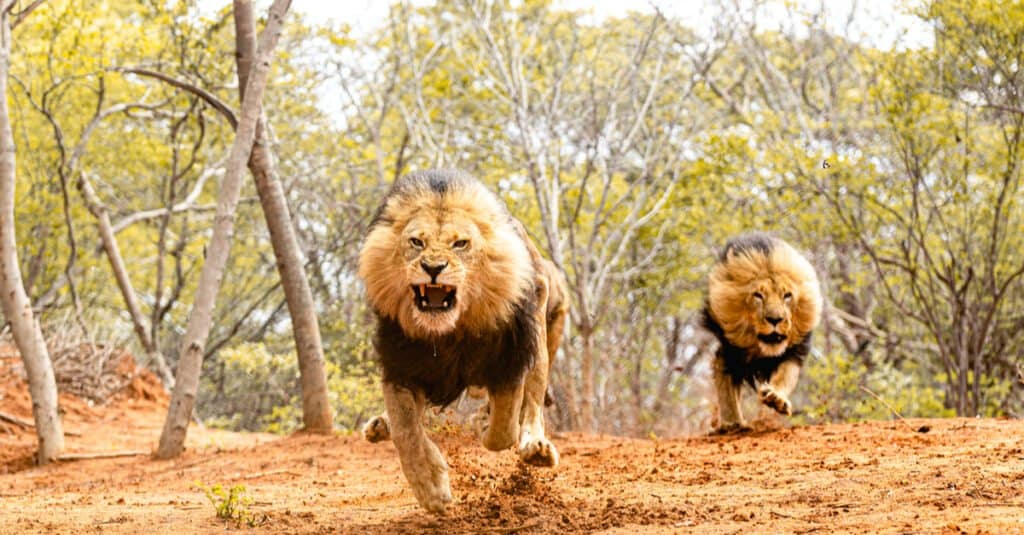
Bears are longer, heavier, and taller than lions, and bears fight on two legs while lions fight on all four.
©Blue Slate Films/Shutterstock.com
A bear is an omnivore that can weigh over 900 pounds and stand 9 feet tall on two legs in a fight, and a lion is a carnivore that weighs about 500 pounds and has a length of 8 feet. Both of these mammals are apex predators in their area of distribution for the most part, with adults rarely falling victim to others.
Other notable differences include the bear’s ability to stand on two legs for short times and the lion’s extra layer of protection for its neck in the form of a mane.
Who Would Win in a Fight Between a Bear and a Lion?
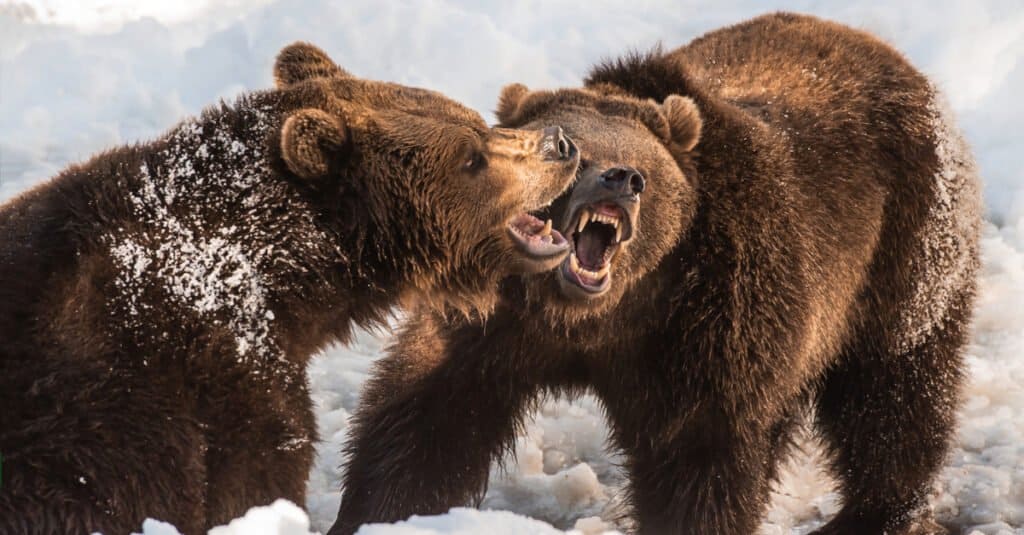
Bears would prove themselves to be the ultimate predator by beating a lion in a fight.
©Alexandra Giese/Shutterstock.com
A bear would win a fight against a lion. Bears have the advantage in just about every aspect, from size to offensive capabilities. The only time that a lion would win is if it managed to sneak up and ambush a bear, leaping onto it and biting into its head with such power that it shattered the skull.
The more likely case is that the two would be aware that the other is nearby, leading to a running clash of the enemies. The bear would rear up onto two feet and the lion would look to strike at the vulnerable stomach and legs.
The lion would certainly do some damage with an initial bite, but it’s not quick enough to escape without injuries of its own. The bear could smash the lion with devastating paw and claw strikes and then move in for a bite to cause serious injuries.
This fight would probably not be over quickly, but the lion would take far more damage than it gives. In the end, the bear would be hurt, but the lion would be dead. Of course, a pride of lions would certainly win against a lone bear.
A Question of Social Organisation

Lions are gregarious by nature and tend to hunt or take on opponents in groups increasing their likelihood of success
©Maryke Scheun/Shutterstock.com
The above outcome is based on the outcome of one bear taking on a single lion. However, it is worth noting that bears are generally solitary, while lions are more gregarious and tend to wander about in groups or even with an entire pride. In which case, victory might just be a question of lifestyle. Since the bear’s certainty of victory will most likely fizzle away in the presence of three adult males, Or even a pride with a lion backed up by four lionesses. And while it is likely the bear won’t go down without a fight or that heavy casualties are likely to occur, victory in this latter case might just go to the lion, and its supporting cast.
Another Animal that Could Take Down a Bear: Bear vs Jaguar
In combat, a jaguar would lose to a grizzly bear. The jaguar lacks the attack strategies needed to take down a grizzly bear. We’re not sure the big cat will be able to bite through all the layers of hair, flesh, and fat to administer a lethal, crushing blow to a grizzly bear’s massive skull, even if the fight sprang from an ambush.
Instead, the jaguar would undoubtedly strike and cause injury. The largest challenge a grizzly would face would be getting near to the large cat, which the beast would unintentionally solve.
By pinning the jaguar, the grizzly would turn the tables and launch its savage assault. It can attempt to flee by biting the cat’s neck and back.
While it would be an interesting fight to see, it is unlikely these two animals would ever be faced head-to-head.
The photo featured at the top of this post is © Blue Slate Films/Shutterstock.com
Thank you for reading! Have some feedback for us? Contact the AZ Animals editorial team.






